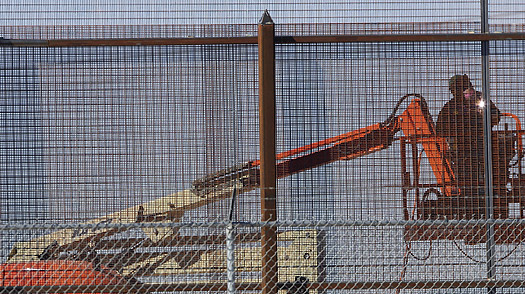
Federal bureaucrats call it the “border fence.” The residents along the Texas-Mexico border say it’s a wall echoing the Cold War. And south of the Rio Grande, Governor Humberto Moreira of the Mexican state of Coahuila has dubbed it a “wall of hate.” But no matter what the controversial barrier being constructed between Mexico and the U.S. is called, the $1.6 billion, 670-mile-long first phase is close to completion as President Barack Obama enters office.
And for Obama, who voted for the border-fence bill back in 2006, the barrier may be best described as a big potential headache. Opponents are already appealing to him to halt construction and re-evaluate the project. But so far, the new Administration has given no indication that it is seriously considering doing so. While it has said it will make comprehensive immigration reform a priority, a spokesperson told TIME that Obama supports the fence “as long as it is one part of a larger strategy on border security that includes more boots on the ground and increased use of technology.”
This, despite repeated pleas from border Democratic officeholders, residents with family and business ties on both sides of the river, and conservationists who fear their 30-year effort to string parcels of land into a necklace of treasured preserves for native fauna and flora will be destroyed as the acreage ends up in a riverside no-man’s-land. On Wednesday, Obama’s first day in office, advocates of immigration reform are holding a rally in Washington in which a multisectarian group of religious leaders will give the Immigration and Customs Enforcement Building a ritualistic cleansing to highlight the call to end workplace immigration raids and the construction of the border fence.
A map on the home page of the U.S. Customs and Border Protection website shows the daily progress of the border-fence construction — green for completed, yellow for under construction and red for planned. There is a line of green and yellow for the 693-mile border between Mexico and the states of California, Arizona and New Mexico. The colors turn to red on the far western and eastern edges of the 1,241-mile Mexico-Texas border. In between, there are just small patches of red, since only 110 miles of Texas border fence are planned in the initial stage.
But those 110 miles have proved the most problematic for the Department of Homeland Security, the agency charged with overseeing the project. While much of the U.S. land on the border west of Texas is held by the Federal Government or large landowners, the projects planned for Texas involve negotiating with a hodgepodge of cities, private landowners, tribal lands, farmers and conservationists.
“It’s a sorry piece of work,” says Mayor Chad Foster of Eagle Pass, Texas. Foster chairs the Texas Border Coalition, a group of cities, landowners, nonprofit conservation groups and Native American tribal communities that has sued the Federal Government to block construction in some areas. Plans in Eagle Pass, some 500 miles east of El Paso, call for the wall — now about 30% complete — to cross a municipal golf course. Initially, the city welcomed the idea of stadium lights on the bluff overlooking the city and the construction of a decorative fence, but when the plans were revealed, the wall-like barrier prompted community opposition. “One size doesn’t fit all,” insists Foster, whose community of some 50,000 people has close business ties to neighboring Piedras Negras, a city three times the size of its U.S. neighbor. He has pressed for a variety of alternative approaches, including the use of sensors to detect illegal movement and the eradication of “Carrizo cane” — an invasive, nonnative, tall river weed that provides easy hiding places along the riverbanks.
See who’s who in Barack Obama’s White House.
See pictures of Barack Obama’s Inauguration.